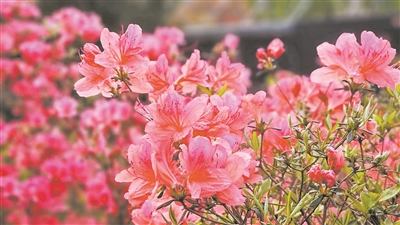A University's Blooming Success with Azalea

Azalea blooms in the biological park in the North district of Jinggangshan University. (PHOTO provided by Jinggangshan University)
By WEI Yichen & LIANG Yilian
Typically, the "Yingshanhong" flower, commonly known as azalea, planted in in the Jinggangshan region of Jiangxi province, bloom in early spring between February and March, with a flowering period lasting just over a month. But with sun scorching in July, you can still see the azalea in full bloom thanks to a scientific research team at Jinggangshan University (JGSU) . The researchers have spent 13 years developing a technology that allows azaleas to bloom throughout the year.
Breaking the 'dormancy'
In 2011, Hu Xuehua, a senior experimentalist at JGSU, led his team with the dream of "making azalea bloom in winter and summer." The first challenge was to identify all the factors affecting the flowering decision. Azaleas prefer a cool environment, entering a dormant state when temperatures rise above 30 °C. Under natural conditions, azaleas break dormancy through exposure to low winter temperatures.
The team initially tried using cold storage facilities to simulate winter conditions. However, they could only advance the flowering period by about a month.
"It's still too short a time," Hu told Science and Technology Daily. After extensive exploration, the team discovered that azaleas are very light-sensitive. Excessive sunlight can cause the flowers to burn or die. This led Hu to propose a new idea: "Can we change the time the flowers bloom by controlling the time of light?"
Finding the best ‘formula’
In JGSU's biological park flower control room, rows of plant-filling lights hang inside. "By adjusting the number of lights on, changing the height of the light source and other methods, we make the light intensity change at different times of the day, so that azalea mistakenly thinks that time flows and day and night alternate," Hu said.
Another significant experiment involved using growth regulators. "After several years of testing, we created a new growth regulator formula for azalea. One to two months before the flowering period, we estimate the flowering period based on the maturity of the buds and decide whether to speed up or delay the flowering," said senior experimenter Li Xiaohong at JGSU.
Additionally, the team used environmental control measures such as temperature adjustment and plant pruning to precisely regulate the flowering period. In October 2018, they finally found the optimal formula combining light, temperature, regulator concentration, and physiological and biochemical factors.
Red flowers bring profits
"With the formula, you can make the azalea bloom anytime and anywhere," said Hu.
This technology has been authorized by one international patent and two national invention patents, according to Hu.
"In 2022, JGSU began to cooperate with our county," said Li Ping, head of the azalea planting professional cooperative in Shuicha town, Taihe county, Jiangxi Province.
Over the past two years, the technology has enabled local villagers to breed 50,000 seedlings annually, supporting over 200 returnee entrepreneurial youth. This initiative has generated an overall output value of more than 15 million RMB, benefiting more than 2,000 people.






